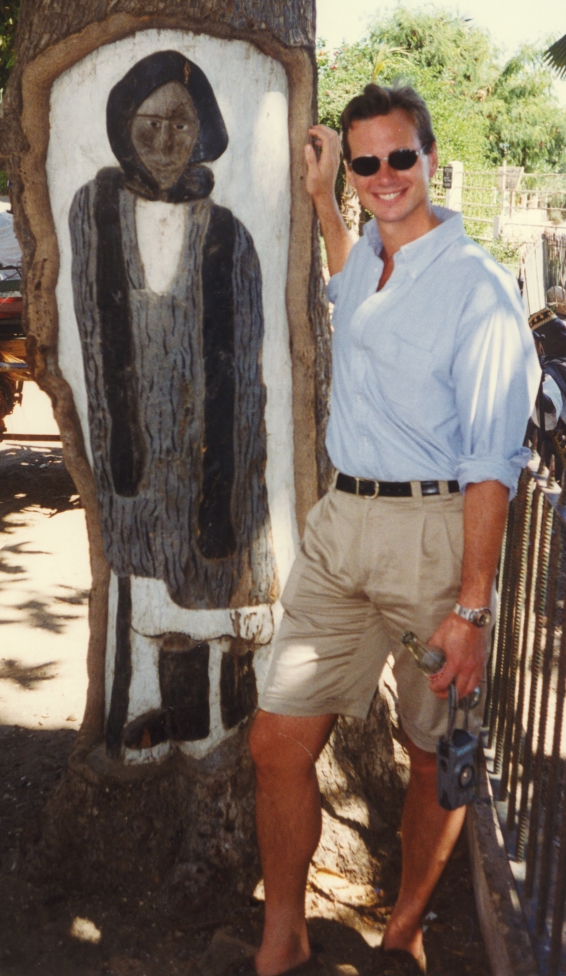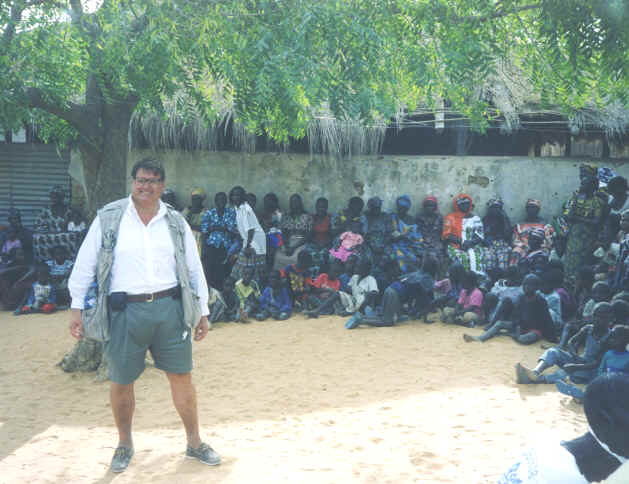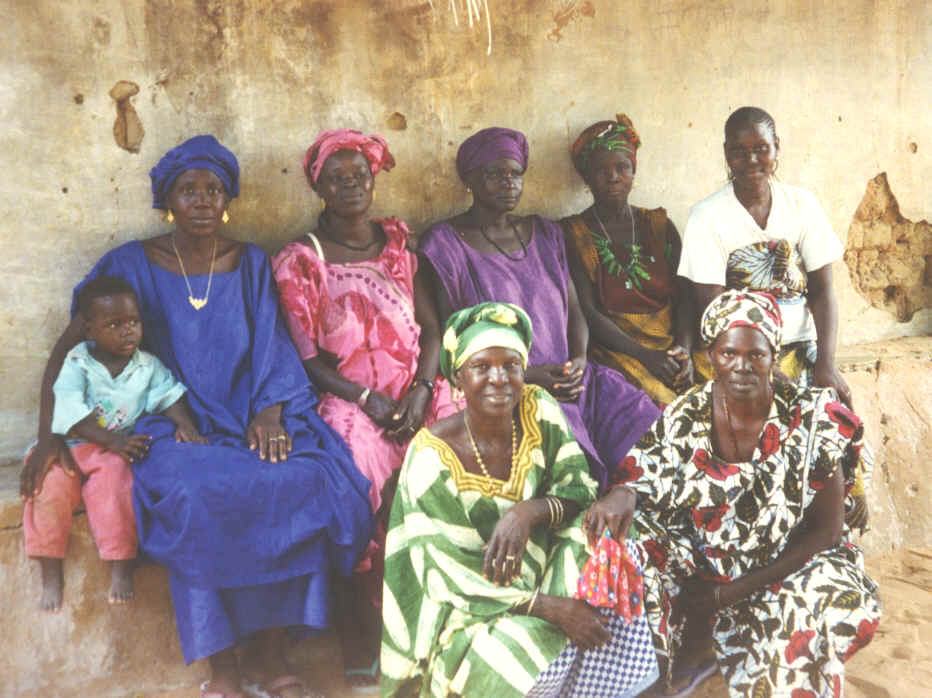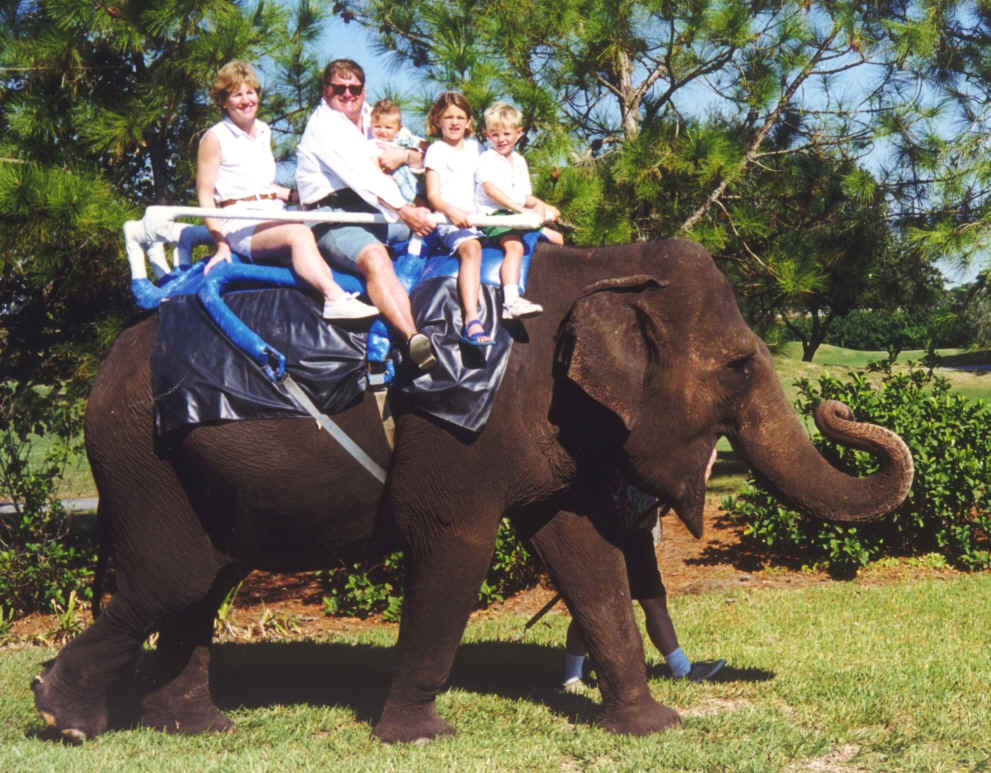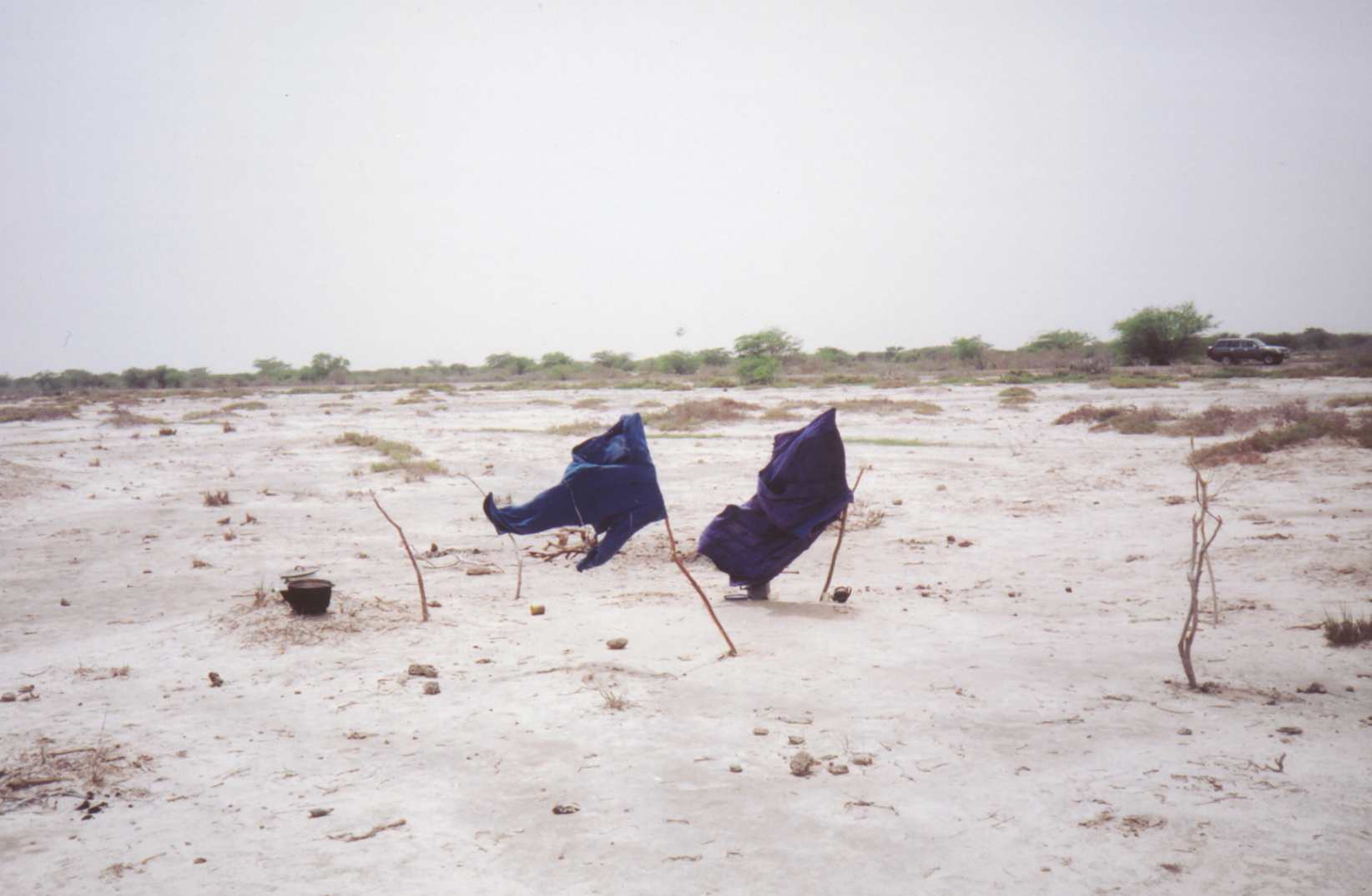
One of the numerous baby Ronalds named after our beloved King.
PEOPLE AND CULTURES
The ethnic groups of Biffeche live together in harmony, united by their love for the Kingdom, mutual respect, and pious submission to, and appreciation of God's will. Although there are some common cultural practices unique to Biffeche, each group brings its own rich heritage and culture; many noble races and ancient Kingdoms and empires enrich our Kingdom today.
Ethnic groups include Peulh (Fula), Sérér-Ndut, Wolof, Naar (Moor) and American, but all are truly called "the Biffeche".
The Peulh (also called Fula or Ful Fulde) are a nomadic pastoral race, guiding their herds all across West Africa. They are the only nomadic pastoral race in all of West Africa (hence in Biffeche). Unlike the case in East Africa with pastoral nomads, the Fula get along well with the non-pastoral groups in Biffeche among whom they live. They are the largest ethnic group in Biffeche, spread across the countryside in numerous villages. They are a proud race, noble in appearance. "Our language is Pulaar, the most harmonious sounding, and yet perhaps the most complicated of all Biffeche languages." Tukulor people here also speak Pulaar. Most are devout Muslims, a few are Christian and several groups are traditionalist.
The Sérér-Ndut are a handsome race that once inhabited Biffeche and the rest of the Sénégal Valley in ancient times, but were driven out centuries ago by invaders from the north. Tillers of the soil, they settled as part of the Sérér cultures in central Sénégal, especially in the area known as Mont-Roland west of the city of Thies. In the mid-20th Century, life became too hard, and a group were resettled to Biffeche-Ville (now called M'Boubene) around 1960. They were put in tragic starvation-conditions, and they did not receive promised support. It is they who "founded" Biffeche-Ville as such, and arranged for the anointing of King Edward I (the American King of Biffeche). These elders are honored today as "the founders" and have been awarded the Biffeche Order of St. Michael medal. The Sérér-Ndut language is related to Sérér-Sine, and is spoken by 25,000 people, not all of whom are in Biffeche. The Sérér tend to be conservative, and more careful with their money than the Wolof. In Biffeche most are Roman Catholic Christian and traditionalist.
The Wolof are the dominant group in Sénégal, although they are just one of the main groups in Biffeche. Their language is gradually becoming the language of the whole region. In most of Biffeche, the Wolof language is a lingua franca even more than French itself. The Wolof are known for their industriousness, intelligence and showy extravagance, and traditionally they have been socially oriented in a stratified caste system which still exists unofficially. Most are Muslim or traditionalist, and some are members of the great Muslim brotherhoods of Tidjan, Mouride, etc. that have glorious histories in West Africa.
The Naar (or Moors) have cultural affinities to the Arabic-speaking groups to the north and east in places like Mauritania and Mali. They have their own Afrique-du-nord-oriented Islamic culture. In Biffeche, they live mainly in their own sub-villages. All are Muslim.
The Americans appeared in Biffeche life only after the American Edward Charles Schafer became King Edward I in 1963. He codified an aristocracy with local members in Biffeche as well as members in the USA, Great Britain, and Europe (mostly well-to-do patrons who helped the people). His Majesty, King Ronald I, is of Scots, German, Swedish and American ancestry.
Cultural Practices of the Biffeche
There are unique cultural practices that have developed in Biffeche. Some are from ancient times, some were brought to Biffeche in the resettlement of the Sérér-Ndut people in the last century, and others derived more recently from the advent of having an American King.
The three religions practiced in Biffeche are Islam, Roman Catholic Christianity and traditionalist religions combining elements of Fula, Sérér, and Wolof Pangool and Great White Leopard beliefs and practices. The majority of the population in the whole Kingdom are Muslims. Savoigne is the heart of the Christian population. However, even in Savoigne the majority of the population is Muslim. The followers of the traditional religion are scattered universally throughout the Kingdom. There is a mosque and a small but distinguished school of Islamic studies at the capital, M'Boubene (generally revered as a "holy Islamic city" or "Madinat Islamiah" by Muslims), and there are a church and mosque at Savoigne and Savoigne-Pionniers (respectivement). In Savoigne there are Christian shrines to the Virgin Mary (the revered Maryam to Muslims), and a most striking bronze statue of the Cross, Orb Mondiale and Crown of Thorns. The beautiful Centre Saint Blaise at Savoigne is headquarters of the missionary work of the Roman Catholic church.
There is official recognition and respect for all the religions of Biffeche, equally. The Kingdom has both Muslim and Christian Orders of Knighthood and the traditional religion and "pangool" are not neglected.
Certain beliefs and practices are considered private to the groups involved and are not widely disclosed. The "griot" (hereditary minstrel and historical orator) is used in certain Biffeche festivals, including those of the Biffeche Americans. The griot may get involved in certain other things. Importance is given to certain songs and certain kinds of drums and music.
Among legends there is the great Njawoor Ciss, a noble Sérér-Ndut warrior of past times who still returns to help (and sometimes to chastise) his people. There is the Great White Leopard, who moves mysteriously at night and occasionally intercedes in the affairs of the Biffeche people. Lately, some unusual practices surround the tomb of the late King Edward I who was known in America for his vast wisdom. His advocacy with the Almighty has been invoked seeking that wisdom, cures, etc.
When a great personage visits Biffeche (like a King, a Duke, or the Presidents of Mauritania or Sénégal), a bull is killed in honor, and a great feast on the beef is held. Traditional Biffeche drums are played, and hereditary traditional minstrels may sing the praises of the visitor. A Great Drum of Biffeche (an enormous drum made from a hollowed-out Baobab tree section) is mentioned but has not been seen or used to honor visitors in recent years.
When a new King arrives, a Royal Fan Bearer fans Him with a symbolic fan made of river reeds, to cool Him. But when the American Edward I was made King by long-distance investiture in 1963, the ancient West African message of a packet of sacred royal seeds was sent to Him by mail, conferring the Kingship of Biffeche upon Him, along with the investiture documents.
Every major village in Biffeche has a Chef de Village recognized by the King. Visitors always visit the Chef before visiting anyone else in the village, and bring Him the customary presents: dates for the Muslim chefs, dates and kola nuts for the Christian chefs, for the Chef of Grand Leopard Villages the only customary present is gold and this must be given. It is also hoped that visitors will remember small trinkets for the village children as toys are almost unknown in this part of Africa. Visitors get their passports stamped with a "Marque de Visite" of the Kingdom. If the King is present, He is met with a slight bow, with no further special ritual after that. He is first addressed as "Your Majesty," later just as "Bour" (a Sérér-Ndut and Wolof word pronounced Boooorr) or with the French "Roi". Chefs de Village are addressed as "Chef-de-Village," "Chef," or by their aristocratic titles, if any. No important business is discussed without the assent of the Chef de Village.
Although the Biffeche people believe in hard work, we also believe in enjoying ourselves immensely, and, when we can afford it, we have splendid parties and festivals with dances, drumming, food and other acts. We are the envy of all West Africa in these affairs, and to see our women dance is a sight.
Biffeche is the only place in the world where the leaf-shaped Royal Chair is made. It is made from a special grove of river reeds, is saddle or hyperbola shaped, and is sat on unlike any other chair. The King's own Royal Chair is held sacred, but slightly smaller copies may be commissioned and purchased in Savoigne. (More conventional thrones of Biffeche are also kept for the Court in America, Scotland, Germany and Sweden.) For decoration and memento, small reed replicas of the Royal Chair may also be found in Savoigne.
The women of Biffeche are famous for wit, beauty and style, which we maintain even in times of extreme poverty. Many a young Sénégal man comes to Biffeche looking for an ideal wife, and tales are told of the sad lovesick youths who leave the Kingdom rebuffed. In Biffeche, the woman has complete control of her person. This is evident in the rituals as in all things. We gather at the river to fetch water, socialize, and do our routines and cultural practices. The Biffeche woman often wears the most splendid West African dresses, even if she has little money.
The Biffeche man is known to be strong, industrious, pious, shrewd, loyal and friendly. Our men dress in traditional robes or western clothes, much more subdued (except for certain Fula robes) than our women's finery. We wear the Muslim headwear, or else the knitted cap with the traditional Biffeche colors of blue and white; some outside the Kingdom may also wear it in solidarity with our King.
The traditional transport for the Kings of Biffeche was always by camel, but our current King prefers his elephants. He has played elephant polo in Nepal and is saddened that there has not been a wild elephant sighting in Biffeche in some years. His Majesty does find the Asian elephant to be more tractable and easier to ride than our larger African breed. There are no serious disputes in our Kingdom and any contretemps are settled by consultation among our Council of Ancients and community consensus under the guidance of our Chefs and Sou-Chefs des Villages. This is the traditional African way. The King can make his wishes known, but that is rarely needed. For over 50 years, the Kings have rarely held majlis court in Biffeche, although officially any Biffeche person may call for it.
In a field in Biffeche there grows the great Sacred Gui (a large baobab tree), which is the center of certain beliefs, and is never cut or felled. From the fruits of this tree comes Biffeche Royal Bouille, a special delicious white powder used in ceremonial foods for babies.
Biffeche ancients had certain initiations for a boy becoming a man, and a girl becoming a woman, that remain undisclosed. Any bathing ceremonies of youth would be suffused with reverence for the body and wholly consistent with the religious pieties of Islam, Christianity, and the Great White Leopard. Outsiders ignorant of historic culture merely have difficulty in understanding. A system of certain deeper features of the Universe under traditional "Pangool" and Great White Leopard can be harmonized with both Islam and Christianity.
A special mark of honor for a guest in Biffeche is the "triple-tea ceremony." In a special sequence, the lady of the house pours a cup of tea for the guest three times, each stronger than the last, from an elaborate tea-heating and serving apparatus. We are very poor, so this elaborate ceremony carries a great significance of respect. Some old French customs are popular in Biffeche, from the days when much of Afrique de l'Ouest was a French colony, especially the French bread (baguette) obtained daily from the boulangerie in nearby Saint-Loauis, Sénégal. And the well-educated person speaks and cherishes the French tongue.




